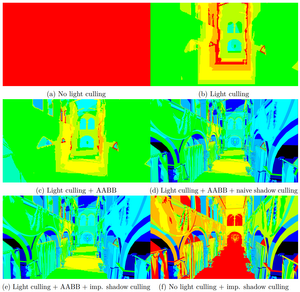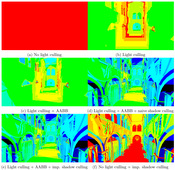Information
- Publication Type: Bachelor Thesis
- Workgroup(s)/Project(s):
- Date: February 2025
- Date (Start): February 2024
- Date (End): February 2025
- Matrikelnummer: 12022518
- First Supervisor: Michael Wimmer
Abstract
In this thesis, we explore the topic of hybrid rendering, which combines rasterization and ray tracing to produce high-fidelity images. While rasterization has been the primary rendering technique for real-time applications for decades, it struggles with producing accurate lighting effects because of its nature of processing each primitive in isolation. Ray tracing has gained in popularity in recent years due to its ability to produce accurate lighting effects, which is one of the primary contributors to perceived visual fidelity. Achieving real-time performance with an entirely ray tracing-based renderer is challenging because of the high number of rays required to produce images. This has motivated the development of renderers that use rasterization as the primary rendering technique and ray tracing for producing lighting effects. The goal of this thesis is to showcase the usage of a forward+ pipeline to build a hybrid renderer utilizing the hardware acceleration of the graphics card for ray tracing tasks. To this end, we build a rendering engine that implements ray-traced hard shadows and explore methods that reduce the number of shadow rays. Shadow ray culling based on the angle of the surface normal with the ray direction and tile-based light culling are the two methods implemented in this work. The results have shown a performance uplift of 39% with the improvements presented in this thesis.Additional Files and Images
Weblinks
No further information available.BibTeX
@bachelorsthesis{elagabani-2025-ieh,
title = "Implementierung eines Hybrid Renderers in Rust unter
Verwendung einer Forward+ Pipeline",
author = "Munir Yousif Elagabani",
year = "2025",
abstract = "In this thesis, we explore the topic of hybrid rendering,
which combines rasterization and ray tracing to produce
high-fidelity images. While rasterization has been the
primary rendering technique for real-time applications for
decades, it struggles with producing accurate lighting
effects because of its nature of processing each primitive
in isolation. Ray tracing has gained in popularity in recent
years due to its ability to produce accurate lighting
effects, which is one of the primary contributors to
perceived visual fidelity. Achieving real-time performance
with an entirely ray tracing-based renderer is challenging
because of the high number of rays required to produce
images. This has motivated the development of renderers that
use rasterization as the primary rendering technique and ray
tracing for producing lighting effects. The goal of this
thesis is to showcase the usage of a forward+ pipeline to
build a hybrid renderer utilizing the hardware acceleration
of the graphics card for ray tracing tasks. To this end, we
build a rendering engine that implements ray-traced hard
shadows and explore methods that reduce the number of shadow
rays. Shadow ray culling based on the angle of the surface
normal with the ray direction and tile-based light culling
are the two methods implemented in this work. The results
have shown a performance uplift of 39% with the improvements
presented in this thesis.",
month = feb,
address = "Favoritenstrasse 9-11/E193-02, A-1040 Vienna, Austria",
school = "Research Unit of Computer Graphics, Institute of Visual
Computing and Human-Centered Technology, Faculty of
Informatics, TU Wien ",
URL = "https://www.cg.tuwien.ac.at/research/publications/2025/elagabani-2025-ieh/",
}

 bachelor-thesis
bachelor-thesis image
image

